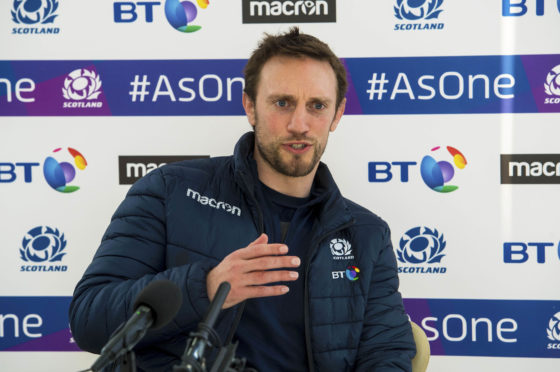It’s only eight years since Mike Blair was involved in a Rugby World Cup build-up as a player rather than a coach, but the difference from then to now is like that between pigeon post and email.
The former Scotland and Lions scrum-half played in three world cups, and former team-mate Chris Paterson reminded him of the preparations for their first, in Australia in 2003.
“Mossy send me some pictures from when we trained in the hothouses at the Botanical Gardens to get 1acclimatised’ for Australia,” he said. “It was bizarre, there was a pond in the middle of the training area and a small width of walkway where they had the rowing machines lined up.
“Of course the machines can move when you row fast and after a bit they were very close to going in the water. One of the pictures Mossy showed me had Gregor running around in there with his gumshield in and boxing gloves on.”
In 2007 it was the famous weight and gym sessions under conditioning coach Mark Bitcon because Frank Hadden wanted the side bulked up – “we had get extra heavy dumbbells for Jason White” recalls Blair – and in 2011 it was endless running under Andy Robinson, although not for the team’s primary scrum-half at that time.
“Everyone speaks about the hellish running we had to do for that one, but I had a foot injury through the build up and basically didn’t do anything until the week before we went to New Zealand,” he admitted.
However Robinson’s regime was the start of the revolution towards rugby-specific conditioning and training which has been turned up to full power by the present management team.
“We don’t do that straight line running anymore for the sake of it, it’s all about game scenarios,” he said. “Games-based conditioning is what we are really big on now.
“The guys did this in the first block and after three weeks off have come back and been tested again, and there’s huge improvements. We now work on conditioning within games and in our rugby.”
Similarly, players now don’t get stir-crazy because their time is better managed.
“It was long days before and I remember hauling up mattresses for sleeping between sessions,” he said. “Now the weeks we have work really well.
“For example we start later Monday for the guys coming from Glasgow to spend their Sundays at home. One the weekday sessions everything is finished by 3.30pm so they miss the Edinburgh traffic.
“So long as we get in and get the job done, there should be any hanging around for the guys. They are working hard, just when you get the GPS stuff back now you can check if the accelerations are high and the top speeds are high, and you can take things back a bit.
“We’ve also been to Portugal, had a spell in Inverness and we wil be going to St Andrews next week. It is important to do that because the World Cup is away from home and not a settled environment, we have four days here, 12 days here, six days there – you need to get used to training in different environments and playing them as well.
“We’ve had those blocks and we’ll move into test-match week preparation as the warm-up games get closer.”
Blair feels this squad are balanced well between veteran players who seen everything and new faces bringing and freshness.
“It is a balance of a squad, a balance of opinions and experiences,” he said. “You need your guys who have been there for the last seven or eight years but you also need your guys who have been there for a year.
“The young guys, the fearlessness, the energy, the exuberance they bring to the group, you need to harness that. It will often lift the guys who are maybe starting to feel a little old, they will come in and raise them and in turn the older players don’t want to show the young guys that they are feeling old. That balance within the squad is really important.
“Also you want a mix of personalities within the squad, that is massively important. It’s building a group who want to play for each other but also want to have fun off the pitch because we feel that marries in well with what happens on the pitch.
“Having really studious guys and guys who really bring energy off the pitch build a squad together is really important.”
